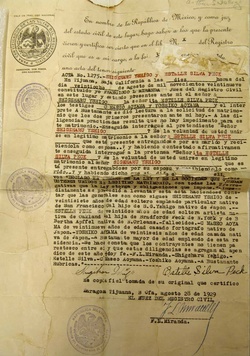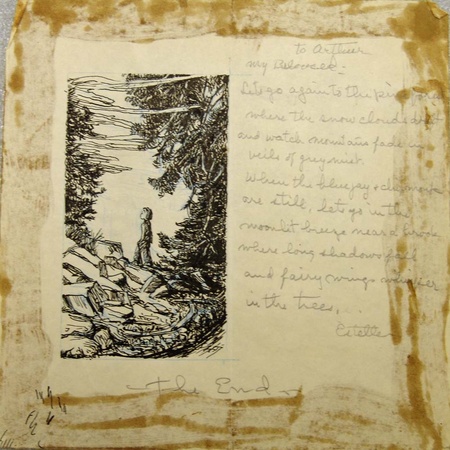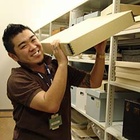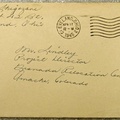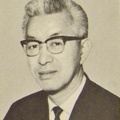Estelle Ishigo is a name that may be familiar to many of you. She was one of the few whites to be incarcerated with Japanese Americans during World War II. Estelle voluntarily chose to enter Heart Mountain Relocation Center in order to stay with her Nisei husband, Arthur Ishigo. She authored the book Lone Heart Mountain (1972) and was the subject of Steven Okazaki’s Academy Award winning film Days of Waiting (1990). While Ishigo’s artwork is highly acclaimed in Japanese American history, I believe that too often it alone is objectified, leaving the artist herself completely invisible.
Born in 1899 in Oakland, California, Estelle was virtually abandoned by her artist parents at the age of twelve, when she moved to Southern California to live with a variety of relatives and strangers. While in her twenties, she enrolled in the Otis Art Institute and met an aspiring Nisei actor named Shigeharu Arthur Ishigo. In her own words, it was “love at first sight.” Little did she know at the time how this single moment would change her life forever.
A simple internet search for Estelle’s biography would tell you that she married Arthur in 1929, however, this fails to mention the rampant anti-miscegenation laws (and public sentiment) of the time. While perusing the hundreds of pieces related to Estelle in JANM’s archives, I came across the Ishigos’ marriage certificate…in Spanish! In order for the two to wed, they had to travel across the Mexican border to Tijuana. While this may seem ludicrous to young Americans today, it sadly was a reality until not so long ago. As soon as Estelle and Arthur were married, Estelle’s family essentially disowned her, and nothing of them is ever mentioned again.
Following the bombing of Pearl Harbor on December 7, 1941, the Japanese American community immediately encountered a myriad of problems. By December 8th, many had been fired for being ethnically Japanese, including Arthur Ishigo. Within two weeks, Estelle herself was fired just for having a Japanese last name. Soon, it became clear that all Japanese Americans on the west coast would be sent into concentration camps.
“Arthur and I were faced with the choice of separating or going into the camps together. I could not desert him. I wanted to stay with him no matter what happened, no matter where we were sent. We’d been married for thirteen years.”
So Estelle joined Arthur, first at the Pomona Assembly Center, and then on to Heart Mountain, Wyoming. A skilled artist, Estelle recorded the sights of camp in her hundreds of sketches. Many of her drawings are on display throughout the country (as well as on JANM’s website), and this is often cited as her greatest lasting legacy. In an age before digital cameras and instant sharing, and in a place where even film cameras were banned, Estelle recorded the shocking sights taking place directly in front of her eyes, all the way until the final day of the concentration camp’s operation.
“Some have wondered why I went to that camp with my husband and also what it was like being married to a Japanese before the war and in the camp. In a time of hostility and danger, if one is in love the greatest desire is to stay close to one’s own.”
World War II may have finally ended in 1945, but anti-Japanese racism was still thriving throughout the Los Angeles region. The Ishigos struggled to find steady work in the years immediately following their return to California. Arthur eventually gained employment in the airline industry, but soon had cancer and passed away in 1957 at the age of 55. To Estelle, the wide-eyed enthusiasm of Arthur from before the war had faded to the point where he had just become a shell of his former self, physically and emotionally drained from years of unjust incarceration.
Estelle lived in seclusion until 1972, when the California Historical Society approached her to share her drawings and sketches for an exhibit. In 1983, some former Heart Mountain incarcerees found her living in a basement apartment in Los Angeles off of a $5 weekly stipend. She had lost both of her legs from gangrene. According to Days of Waiting filmmaker Steven Okazaki, “She said, ‘I’ve been waiting for someone to tell my story. Now I can die.’” Sadly, she did pass away in February 1990 and was never able to see Okazaki’s film.
When I think about Estelle’s story, it truly is a heartbreaking tale filled with so many traumatic events, from her parents abandoning her, to a childhood rape, to decades of discrimination and apathy from her very own society. Yet, one crucial element of Estelle’s story is often overlooked: her undeniable love for Arthur.
I also recently came across a sketch and poem done by Estelle, complete with pencil eraser marks and remnants of glue around the border. Estelle once said, “To get away [from discrimination], we went camping in the mountains as often as we could. Those were good times, I was happy.” Since virtually all of her artwork on public display is related to the horrors of racism and injustice, it is often easy to forget about who she really was.
This particular piece removes all contexts of race, camp, and injustice, and replaces it with fond memories, heavenly dreams, and a romance to last an entire lifetime. Often forgotten and ignored underneath all the layers of pain and suffering, Estelle Ishigo was just a woman so in love with her husband that she was literally willing to travel to the end of the world to be with him.
to Arthur
my beloved:
Let’s go again to the pine forest
Where the snow clouds drift
And watch mountains fade in
Veils of grey mist.
When the bluejay & chipmunk
Are still, let’s go in the
Moonlit breeze near a brook
Where long shadows fall
And fair wings whisper
In the trees.
Estelle
© 2012 Dean Adachi


